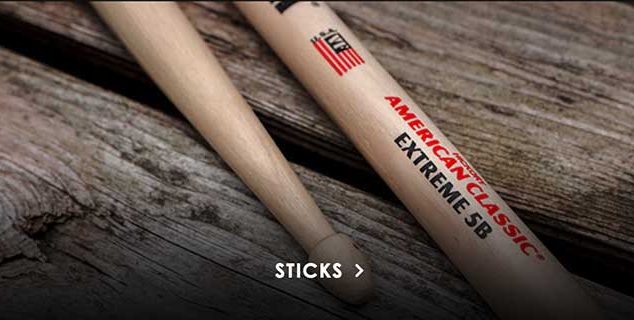READING MUSIC WITH WEBRHYTHMS:
LESSON NINE
Welcome to WebRhythms – an easy step-by-step method for learning to read rhythm, created by Vic Firth artist and educator Norm Weinberg. Starting at the very beginning, you’ll progress through 20 lessons, where each introduces a new topic. By the end of the series, you’ll be a master at reading rhythm!
In this WebRhythms lesson, you’ll learn about quarter note triplets. The exercise you’ll be working on in this lesson will include audio play-along tracks in five different levels that you can use to track your progress!
QUARTER NOTE TRIPLETS
In the world of contemporary music, there are few universal laws. When the traditional concepts of harmony, melody, structure, and rhythm are being pushed to the limits, is there anything that you can depend on? One universal axiom, no matter what the music or style, is that “two eighths always equal a quarter”.
When we first introduced quarter notes and eighth notes in this series of lessons, you learned that eighths divide quarters into two equal parts. In 4/4 meter, quarter notes equal the value of one full count, while eighth notes receive the value of one-half count each. You perform eighth notes by placing a stroke on the number count and on the “and” syllable. With this in mind, it would be possible to explain quarter notes as simply playing every other eighth note. To say this another way, if you wanted to play a series of quarter notes, just strike the drum on the number counts and leave out the “and” syllables. The quarters will be performed correctly, because they still have the value of two eighths (the eighth you play and the eighth you leave out). With this type of approach, you’re not dividing quarter notes into two eighths, you’re doubling the value of eighths in order to play quarters. And, two eighths always equal a quarter.
Time out! Didn’t we say last lesson, that if eighth notes are triplets, then three, not two, equal the value of the quarter? Well, yes. But eighth note triplets are not eighth notes…they’re triplets! If, on the other hand, you relate eighth note triplets to quarter note triplets, then the rule still holds true: “two eighth note triplets always equal a quarter note triplet”.
This rule brings us to the new rhythm for this lesson, quarter note triplets. Let’s apply this same plan of attack.
When eighth notes are triplets, three of them have the value of a single quarter. In 4/4 meter, each triplet eighth note has the value of one-third of a count. Since we’re assuming that “two eighths always equal a quarter” then a triplet quarter note has the value of two-thirds of a count. The end result is that playing every other eighth note triplet will give you quarter note triplets.
Take a look at example 1. Here, you see that eighth note triplets (the rhythm on the bottom) move twice as fast as quarter note triplets. By counting eighth note triplets (1-and-ah-2-and-ah) and striking the drum on every other syllable, you can correctly perform quarter triplets (playing on the “1”, the “ah” of the first count and the “and” of the second count).

Here’s a little exercise. Play a measure of eighth note triplets beginning with your right hand. During the first measure, play every note on the drumhead. When you arrive at the second measure, play the drum with your right hand and move your left hand to the rim. Guess What? Your right hand has just performed two measures of quarter triplets!

Notice that when quarter note triplets are written, in addition to the number “three”, you’ll see a little bracket. Although not a necessity in all notation, the bracket gives a helping hand to the performer by indicating exactly which notes are included in the triplet.
Although quarter triplets aren’t very hard to play, most drummers learning how to read don’t play them correctly. The trick to playing quarter triplets is to count every eighth note triplet syllable. Never try to perform them by counting only the syllables that are struck, it just won’t work. Example 3 shows the rhythm most drummers play if they are not subdividing and counting all of the eighth triplets. Notice that measures one and two are very similar, but not quite the same. In measure one, the first two notes have the same value as three sixteenths (dotted eighth, and sixteenth note plus an eighth rest), but the third note has the value of only two sixteenths. The bottom line is that all three notes are not of equal length.

You might remember a helpful hint that was presented in the last lesson: triplets are three notes in the time of two. When applying this rule to quarter note triplets, there will be three quarter note triplets in the same amount of time as two “normal” quarter notes. For this reason, a grouping of three quarter triplets evenly divides two counts into three equal parts.
Let’s now back up and take one last look at some variations of eighth note triplets. Would it be possible to replace one of the eighth notes in a triplet figure with an eighth rest? You bet it would! As long as the triplet figure remains intact, any individual note can be replaced by its rest.
Example 4 shows several variations that are created when one or more notes are replaced with rests. The first measure shows the result when the eighth rest replaces the second note of the triplet figure. I’m sure that you’ve heard this rhythm before, as it happens to be the “swing” cymbal rhythm. Just like quarter note triplets, these figures are most easily and accurately performed if you continue to count all of the syllables for eighth triplets, even though you may only be striking the drum on some syllables. The second measure has the triplet eighth rest replacing the third note of the triplet. Again, the bracket is used to help the performer “sight-out” the triplets within the bar. Looking at the last measure of the example, notice that only the third eighth of the triplet is struck.

When working on the exercise for this lesson, be sure to count every syllable out loud. You’ll find that hearing the subdivided eighth triplets will help you play more accurately and securely. One of the tricky aspects of this example is playing the dotted eighth/sixteenth figures so that they sound different than triplets. After all, sixteenths divide a count into four parts while eighth triplets divide the same count into three parts. The space between notes is longer for triplets than sixteenths. When you feel comfortable and relaxed with the exercise, try to bring up the tempo. Remember to play everything with a smooth and flowing feel.
PRACTICE THIS EXERCISE WITH THE PLAY-ALONG TRACKS!





